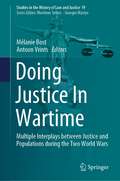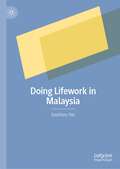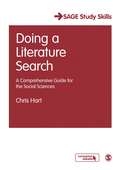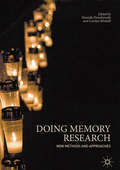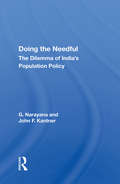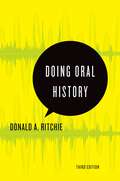- Table View
- List View
Doing Junior Uni: Evidente und heimliche Ordnung einer Kinderuniversität (Kindheit als Risiko und Chance)
by Miriam BöttnerOrganisiertes Lernen findet in unserer Gesellschaft in spezifischen Ordnungsarrangements statt, die weit mehr regeln als nur den Erwerb bestimmter intellektueller Fähigkeiten. Miriam Böttner gibt mittels Feinanalysen von Videodaten einen Einblick in das Interaktionsgeschehen in der ‚Junior Uni‘ und die hier zu beobachtenden Ordnungsprozesse. Über verschiedene Formen der Datenaufbereitung macht die Autorin sichtbar, dass es an einer Kinderuniversität nahezu allen an der Interaktion beteiligten Akteuren schwer fällt, den Anspruch, Lernen in ein neues Arrangement zu verlagern, einzulösen. Sie ziehen sich häufig auf ein Lehr-Lernarrangement zurück, bei dem sich schul- und altersspezifische Körper-Raum-Konstellationen sowie Rede- und Schweigegebote verstetigen.
Doing Justice In Wartime: Multiple Interplays between Justice and Populations during the Two World Wars (Studies in the History of Law and Justice #19)
by Mélanie Bost Antoon VrintsThis book discusses the impact of war on the complex interactions between various actors involved in justice: individuals and social groups on the one hand and ‘the justice system’ (police, judiciary and professionals working in the prison service) on the other. It also highlights the emergence of new expectations of justice among these actors as a result of war. Furthermore, the book addresses justice practices, strategies for coping with the changing circumstances, new forms of negotiation, interactions, relationships between populations and the formal justice system in this specific context, and the long-term effects of this renegotiation.Ten out of the eleven chapters focus on Belgian issues, covering the two world wars in equal measure. Belgium’s diverse war experiences in the twentieth century mean that a study of the country provides fascinating insights into the impact of war on the dynamics of ‘doing justice’. The Belgian army fought in both world wars, and the vast majority of the population experienced military occupation. The latter led to various forms of collaboration with the enemy, which required the newly reinstalled Belgian government to implement large-scale judicial processes to repress these ‘antipatriotic’ behaviours, in order to restore both its authority and legitimacy and to re-establish social peace.
Doing Justice, Preventing Crime (Studies in Crime and Public Policy)
by Michael TonryPunishment policies and practices in the United States today are unprincipled, chaotic, and much too often unjust. The financial costs are enormous. The moral cost is greater: countless individual injustices, mass incarceration, the world's highest imprisonment rate, extreme disparities, especially affecting members of racial and ethnic minority groups, high rates of wrongful conviction, assembly line case processing, and a general absence of respectful consideration of offenders' interests, circumstances, and needs. In Doing Justice, Preventing Crime, Michael Tonry lays normative and empirical foundations for building new, more just, and more effective systems of sentencing and punishment in the twenty-first century. The overriding goals are to treat people convicted of crimes justly, fairly, and even-handedly; to take sympathetic account of the circumstances of peoples' lives; and to punish no one more severely than he or she deserves. Drawing on philosophy and punishment theory, this book explains the structural changes needed to uphold the rule of law and its requirement that the human dignity of every person be respected. In clear and engaging prose, Michael Tonry surveys what is known about the deterrent, incapacitative, and rehabilitative effects of punishment, and explains what needs to be done to move from an ignoble present to a better future.
Doing Justice, Preventing Crime (Studies in Crime and Public Policy)
by Michael TonryPunishment policies and practices in the United States today are unprincipled, chaotic, and much too often unjust. The financial costs are enormous. The moral cost is greater: countless individual injustices, mass incarceration, the world's highest imprisonment rate, extreme disparities, especially affecting members of racial and ethnic minority groups, high rates of wrongful conviction, assembly line case processing, and a general absence of respectful consideration of offenders' interests, circumstances, and needs. In Doing Justice, Preventing Crime, Michael Tonry lays normative and empirical foundations for building new, more just, and more effective systems of sentencing and punishment in the twenty-first century. The overriding goals are to treat people convicted of crimes justly, fairly, and even-handedly; to take sympathetic account of the circumstances of peoples' lives; and to punish no one more severely than he or she deserves. Drawing on philosophy and punishment theory, this book explains the structural changes needed to uphold the rule of law and its requirement that the human dignity of every person be respected. In clear and engaging prose, Michael Tonry surveys what is known about the deterrent, incapacitative, and rehabilitative effects of punishment, and explains what needs to be done to move from an ignoble present to a better future.
Doing Justice to Young People: Youth Crime and Social Justice
by Roger SmithThere is an impasse in current thinking about youth crime and justice, represented by punitive and harmful practices, and liberal objections to these processes on the other, based predominantly on arguments for ‘rehabilitation’. This book aims to arrive at an alternative strategy for resolving the tensions between young people – especially those on and beyond the margins – and the social world which frames their lives.The book is split into three sections: Part 1 focuses on young people, their attitudes and behaviour; Part 2 considers the way in which their behaviour is constructed as criminal and then addressed; Part 3 considers the limitations of current practices and potential alternatives. Within this broad framework, the differentiated and contested nature of young people’s experiences and our (and their) ideas of ‘youth’ can be counterposed to prevailing one-sided and often discriminatory assumptions about them; in order then to open up questions about the nature and purposes of the youth justice system, and to introduce some possibilities for reconstructing it according to fundamental principles of rights, welfare and social justice.Doing Justice to Young People will be essential reading for anybody working in or studying youth crime and youth justice.
Doing Justice to Young People: Youth Crime and Social Justice
by Roger SmithThere is an impasse in current thinking about youth crime and justice, represented by punitive and harmful practices, and liberal objections to these processes on the other, based predominantly on arguments for ‘rehabilitation’. This book aims to arrive at an alternative strategy for resolving the tensions between young people – especially those on and beyond the margins – and the social world which frames their lives.The book is split into three sections: Part 1 focuses on young people, their attitudes and behaviour; Part 2 considers the way in which their behaviour is constructed as criminal and then addressed; Part 3 considers the limitations of current practices and potential alternatives. Within this broad framework, the differentiated and contested nature of young people’s experiences and our (and their) ideas of ‘youth’ can be counterposed to prevailing one-sided and often discriminatory assumptions about them; in order then to open up questions about the nature and purposes of the youth justice system, and to introduce some possibilities for reconstructing it according to fundamental principles of rights, welfare and social justice.Doing Justice to Young People will be essential reading for anybody working in or studying youth crime and youth justice.
Doing Lifework in Malaysia
by Souchou YaoMalaysia is a prosperous, developing nation in Southeast Asia. Its citizens face the problems that beset people’s lives all over the world. These problems are about the family and economic security, as well as the existential choices we customarily associate with the residents of developed societies. Through the anthropologist’s art of ethnography and cultural analysis, the book shows the way ordinary Malaysians manage the contingencies, the chanciness in their daily existence. In a mildly postcolonial gesture, Doing Lifework in Malaysia transports the work of Heidegger, Arendt, Camus, Sartre—masters of European existentialism—to a recognizably ‘Third World’ situation. The result is a series of penetrating and illuminating essays that cover a broad range of social actors, among them a Tamil domestic servant, the film maker Jasmin Ahmed, a Malay corporate wheeler-and-dealer turned ecologist, a group of Chinese traders in the Sarawak interior and a female ex-communist insurgent. As such, this fascinating study examines the Malaysian social life afresh, and in the process brings into focus issues not normally covered in other accounts: Hindu worship as a defiance against tradition, gift exchange and globalization, race envy and psychoanalysis, petite capitalism and solitude.
Doing A Literature Search: A Comprehensive Guide For The Social Sciences (PDF)
by Christopher HartDoing a Literature Searchprovides a practical and comprehensive guide to searching the literature on any topic within the social sciences. The book will enable the reader to search the literature effectively, identifying useful books, articles, statistics and many other sources of information. The text will be an invaluable research tool for postgraduates and researchers across the social sciences.
»Doing market« - Unternehmerische Praxis und der Diskurs um »ethnische Ökonomie« im Markt für muslimische Mode in Berlin (Kultur und soziale Praxis)
by Robert BirnbauerUnter dem Schlagwort »ethnische Ökonomie« wird die berufliche Selbstständigkeit von Menschen mit Migrationshintergrund in Politik und Wissenschaft diskutiert. Indem die Selbstständigen ihren »Markt machen«, positionieren sie sich mit dem und gegen diesen Diskurs. Robert Birnbauer zeigt aus einer wirtschaftsanthropologischen Perspektive, wie die Unternehmer*innen dabei ihre gesellschaftlichen Positionen und etablierte ökonomische Wissensbestände gleichermaßen verhandeln. Dazu folgt er dem Diskurs um »ethnische Ökonomie« von der politischen in die unternehmerische Praxis und zeigt: Geschäfte im Markt für muslimische Mode werden zum Resultat gesellschaftlicher Diskurse und der Markt zum Effekt beschreibbarer unternehmerischer Praxis - weit jenseits einer »unsichtbaren Hand«.
Doing Media Research: An Introduction (PDF)
by Susanna Horning PriestEmphasizing conceptual understanding rather than algebra, Doing Media Research: An Introduction provides comprehensive coverage of both quantitative and qualitative social science methods used in research about the media and its role in society. Using straightforward language, author Susanna Hornig Priest shows students exactly how to design and implement meaningful small-scale research projects. This book is based on the philosophy that students can learn methods most effectively through actually using them, and it empowers beginning students to experience research for themselves. This Second Edition features completely revised hands-on exercises and greatly expanded discussions of both media content analysis and the application of social science to new media.
Doing Memory Research: New Methods and Approaches
by Danielle Drozdzewski Carolyn BirdsallMemory studies is a nascent and multidisciplinary research field, drawing from an impressive array of qualitative investigative methods deployed to do memory research. The authors in this collection offer an explicit engagement with the ‘doing’ of memory research. The contributions demonstrate how attention to methodology reveals rich insights about memory and its links to place and identity.
Doing Modernity - Doing Religion
by Hanns Wienold Anna Daniel Franka Schäfer Frank HillebrandtGegenwärtige Zeitdiagnosen sehen sich häufig durch das Religiöse herausgefordert und stellen es in den Mittelpunkt einer Analyse der modernen Gesellschaft. Daneben entwickelt sich in den letzten Jahren eine soziologische Theorierichtung, die eng am Begriff der Praxis ausgerichtet ist und vor allem in ihrer postkolonialen Ausformung universellen Gesellschaftsdiagnosen höchst skeptisch gegenübersteht. Diese Ansätze kommen zu Neudefinitionen soziologischer Grundbegriffe, indem sie etwa die Rolle der menschlichen Körper und der materialen Dinge bei der Entstehung und Reproduktion von Praktiken und Praxisformen zentral thematisieren. Die praxistheoretische Perspektive verspricht, so die Ausgangshypothese des Bandes, nicht nur hinsichtlich der Thematisierung des Religiösen fruchtbare Anknüpfungspunkte für die Religionssoziologie zu liefern, sondern zeigt außerdem, wie sich die Axiome des klassischen Modernitätsdiskurses praxistheoretisch revidieren oder möglicherweise neu fassen lassen.
Doing Multicultural Education for Achievement and Equity
by Carl A. Grant Christine E. SleeterDoing Multicultural Education for Achievement and Equity, a hands-on, reader-friendly multicultural education textbook, actively engages education students in critical reflection and self-examination as they prepare to teach in increasingly diverse classrooms. In this engaging text, Carl A. Grant and Christine E. Sleeter, two of the most eminent scholars of multicultural teacher education, help pre-service teachers develop the tools they will need to learn about their students and their students’ communities and contexts, about themselves, and about the social relations in which schools are embedded. Doing Multicultural Education for Achievement and Equity challenges readers to take a truly active and ongoing role in promoting equity within education and helps to guide them in becoming highly qualified and fantastic teachers. Features and updates to this much-anticipated second edition include: Reflection boxes that encourage students to actively engage with the text and concepts, along with downloadable templates available on Routledge.com "Putting It into Practice" activities that offer concrete suggestions for really "doing" multicultural work in the classroom Fictional vignettes that illustrate the real issues teacher education students face and the ways their own cultural attitudes can impact their response New coverage of issues pertaining to student achievement, federal and state policy, and socioeconomic connections between the current economy and educational funding A more comprehensive discussion about the different social movements that have affected education in the past and present
Doing Multicultural Education for Achievement and Equity
by Carl A. Grant Christine E. SleeterDoing Multicultural Education for Achievement and Equity, a hands-on, reader-friendly multicultural education textbook, actively engages education students in critical reflection and self-examination as they prepare to teach in increasingly diverse classrooms. In this engaging text, Carl A. Grant and Christine E. Sleeter, two of the most eminent scholars of multicultural teacher education, help pre-service teachers develop the tools they will need to learn about their students and their students’ communities and contexts, about themselves, and about the social relations in which schools are embedded. Doing Multicultural Education for Achievement and Equity challenges readers to take a truly active and ongoing role in promoting equity within education and helps to guide them in becoming highly qualified and fantastic teachers. Features and updates to this much-anticipated second edition include: Reflection boxes that encourage students to actively engage with the text and concepts, along with downloadable templates available on Routledge.com "Putting It into Practice" activities that offer concrete suggestions for really "doing" multicultural work in the classroom Fictional vignettes that illustrate the real issues teacher education students face and the ways their own cultural attitudes can impact their response New coverage of issues pertaining to student achievement, federal and state policy, and socioeconomic connections between the current economy and educational funding A more comprehensive discussion about the different social movements that have affected education in the past and present
Doing Narrative Research
by Molly Andrews Dr Corinne Squire Dr Maria TamboukouExamining narrative methods in the context of its multi-disciplinary social science origins, this text looks at its theoretical underpinnings, while retaining an emphasis on the process of doing narrative research. The authors provide a comprehensive guide to narrative methods, taking the reader from initial decisions about forms of narrative analysis, through more complex issues of reflexivity, interpretation and the research context. The contributions included here clearly demonstrate the value of narrative methods for contemporary social research and practice. This book will be invaluable for all social science postgraduate students and researchers looking to use narrative methods in their own research.
Doing Narrative Research
by Corinne Squire Maria Tamboukou Molly AndrewsWritten by an international team of experts in the field, the second edition of this popular text considers both the theoretical underpinnings and practical applications of narrative research. The authors take the reader from initial decisions about forms of narrative research, through more complex issues of reflexivity, interpretation and the research context. Existing chapters have been updated to reflect changes in the literature and new chapters from eminent narrative scholars in Europe, Australia and the United States have been added on a variety of topics including narratives and embodiment, visual narratives, narratives and storyworlds, new media narratives and Deleuzian perspectives in narrative research. This book will be invaluable for all students, researchers and academics looking to use narrative methods in their own social research.
Doing Narrative Research (PDF)
by Corinne Squire Maria Tamboukou Molly AndrewsWritten by an international team of experts in the field, the second edition of this popular text considers both the theoretical underpinnings and practical applications of narrative research. The authors take the reader from initial decisions about forms of narrative research, through more complex issues of reflexivity, interpretation and the research context. Existing chapters have been updated to reflect changes in the literature and new chapters from eminent narrative scholars in Europe, Australia and the United States have been added on a variety of topics including narratives and embodiment, visual narratives, narratives and storyworlds, new media narratives and Deleuzian perspectives in narrative research. This book will be invaluable for all students, researchers and academics looking to use narrative methods in their own social research.
Doing The Needful: The Dilemma Of India's Population Policy
by G. NarayanaThis is a study of the social and cultural roots of the persistent failure of India's attempts to intervene in the realm of population control and related issues of social welfare. The book examines both public and private programmes and policies and concludes with a discussion of prospects for future developments in the population arena and concrete policy recommendations.
Doing The Needful: The Dilemma Of India's Population Policy
by G. NarayanaThis is a study of the social and cultural roots of the persistent failure of India's attempts to intervene in the realm of population control and related issues of social welfare. The book examines both public and private programmes and policies and concludes with a discussion of prospects for future developments in the population arena and concrete policy recommendations.
Doing News Framing Analysis: Empirical and Theoretical Perspectives
by Jim A. Kuypers Paul D'AngeloDoing News Framing Analysis provides an interpretive guide to news frames – what they are, how they can be observed in news texts, and how framing effects are uncovered and substantiated in cultural, group, and individual sites. Chapters feature framing analysts reflecting on their own empirical work in research, classroom, and public settings to address specific aspects of framing analysis. Taken together, the collection covers the full range of ways in which framing has been theorized and applied—across topics, sources, mechanisms, and effects. This volume fosters understanding among the scholarly camps of framing scholars, and encourages greater clarity from framing analysts in all aspects of their empirical inquiry. Chapters offer fresh perspectives from which researchers can begin new research programs, puzzle through perplexing problems in a current research program, or expand an existing program. Providing conceptual and methodological guidance, Doing News Framing Analysis will help framing researchers at all levels to better understand news framing and to improve their future news framing research.
Doing News Framing Analysis: Empirical and Theoretical Perspectives
by Jim A. Kuypers Paul D'AngeloDoing News Framing Analysis provides an interpretive guide to news frames – what they are, how they can be observed in news texts, and how framing effects are uncovered and substantiated in cultural, group, and individual sites. Chapters feature framing analysts reflecting on their own empirical work in research, classroom, and public settings to address specific aspects of framing analysis. Taken together, the collection covers the full range of ways in which framing has been theorized and applied—across topics, sources, mechanisms, and effects. This volume fosters understanding among the scholarly camps of framing scholars, and encourages greater clarity from framing analysts in all aspects of their empirical inquiry. Chapters offer fresh perspectives from which researchers can begin new research programs, puzzle through perplexing problems in a current research program, or expand an existing program. Providing conceptual and methodological guidance, Doing News Framing Analysis will help framing researchers at all levels to better understand news framing and to improve their future news framing research.
Doing Oral History (Oxford Oral History Series)
by Donald A. RitchieDoing Oral History is considered the premier guidebook to oral history, used by professional oral historians, public historians, archivists, and genealogists as a core text in college courses and throughout the public history community. Over the past decades, the development of digital audio and video recording technology has continued to alter the practice of oral history, making it even easier to produce quality recordings and to disseminate them on the Internet. This basic manual offers detailed advice on setting up an oral history project, conducting interviews, making video recordings, preserving oral history collections in archives and libraries, and teaching and presenting oral history. Using the existing Q&A format, the third edition asks new questions and augments previous answers with new material, particularly in these areas: 1. Technology: As before, the book avoids recommending specific equipment, but weighs the merits of the types of technology available for audio and video recording, transcription, preservation, and dissemination. Information about web sites is expanded, and more discussion is provided about how other oral history projects have posted their interviews online. 2. Teaching: The new edition addresses the use of oral history in online teaching. It also expands the discussion of Institutional Review Boards (IRBs) with the latest information about compliance issues. 3. Presentation: Once interviews have been conducted, there are many opportunities for creative presentation. There is much new material available on innovative forms of presentation developed over the last decade, including interpretive dance and other public performances. 4. Legal considerations: The recent Boston College case, in which the courts have ruled that Irish police should have access to sealed oral history transcripts, has re-focused attention on the problems of protecting donor restrictions. The new edition offers case studies from the past decade. 5. Theory and Memory: As a beginner's manual, Doing Oral History has not dealt extensively with theoretical issues, on the grounds that these emerge best from practice. But the third edition includes the latest thinking about memory and provides a sample of some of the theoretical issues surrounding oral sources. It will include examples of increased studies into catastrophe and trauma, and the special considerations these have generated for interviewers. 6. Internationalism: Perhaps the biggest development in the past decade has been the spreading of oral history around the world, facilitated in part by the International Oral History Association. New oral history projects have developed in areas that have undergone social and political upheavals, where the traditional archives reflect the old regimes, particularly in Eastern Europe, the Middle East, Asia, Africa, and Latin America. The third edition includes many more references to non-U.S. projects that will still be relevant to an American audience. These changes make the third edition of Doing Oral History an even more useful tool for beginners, teachers, archivists, and all those oral history managers who have inherited older collections that must be converted to the latest technology.
Doing Oral History (Oxford Oral History Series)
by Donald A. RitchieDoing Oral History is considered the premier guidebook to oral history, used by professional oral historians, public historians, archivists, and genealogists as a core text in college courses and throughout the public history community. Over the past decades, the development of digital audio and video recording technology has continued to alter the practice of oral history, making it even easier to produce quality recordings and to disseminate them on the Internet. This basic manual offers detailed advice on setting up an oral history project, conducting interviews, making video recordings, preserving oral history collections in archives and libraries, and teaching and presenting oral history. Using the existing Q&A format, the third edition asks new questions and augments previous answers with new material, particularly in these areas: 1. Technology: As before, the book avoids recommending specific equipment, but weighs the merits of the types of technology available for audio and video recording, transcription, preservation, and dissemination. Information about web sites is expanded, and more discussion is provided about how other oral history projects have posted their interviews online. 2. Teaching: The new edition addresses the use of oral history in online teaching. It also expands the discussion of Institutional Review Boards (IRBs) with the latest information about compliance issues. 3. Presentation: Once interviews have been conducted, there are many opportunities for creative presentation. There is much new material available on innovative forms of presentation developed over the last decade, including interpretive dance and other public performances. 4. Legal considerations: The recent Boston College case, in which the courts have ruled that Irish police should have access to sealed oral history transcripts, has re-focused attention on the problems of protecting donor restrictions. The new edition offers case studies from the past decade. 5. Theory and Memory: As a beginner's manual, Doing Oral History has not dealt extensively with theoretical issues, on the grounds that these emerge best from practice. But the third edition includes the latest thinking about memory and provides a sample of some of the theoretical issues surrounding oral sources. It will include examples of increased studies into catastrophe and trauma, and the special considerations these have generated for interviewers. 6. Internationalism: Perhaps the biggest development in the past decade has been the spreading of oral history around the world, facilitated in part by the International Oral History Association. New oral history projects have developed in areas that have undergone social and political upheavals, where the traditional archives reflect the old regimes, particularly in Eastern Europe, the Middle East, Asia, Africa, and Latin America. The third edition includes many more references to non-U.S. projects that will still be relevant to an American audience. These changes make the third edition of Doing Oral History an even more useful tool for beginners, teachers, archivists, and all those oral history managers who have inherited older collections that must be converted to the latest technology.
Doing Performative Social Science: Creativity in Doing Research and Reaching Communities
by Kip JonesDoing Performative Social Science: Creativity in Doing Research and Reaching Communities focuses, as the title suggests, on the actual act of doing research and creating research outputs through a number of creative and arts-led approaches. Performative Social Science (PSS) embraces the use of tools from the arts (e.g., photography, dance, drama, filmmaking, poetry, fiction, etc.) by expanding—even replacing—more traditional methods of research and diffusion of academic efforts. Ideally, it can include forming collaborations with artists themselves and creating a professional research, learning and/or dissemination experience. These efforts then include the wider community that has a meaningful investment in their projects and their outputs and outcomes.In this insightful volume, Kip Jones brings together a wide range of examples of how contributing authors from diverse disciplines have used the arts-led principles of PSS and its philosophy based in relational aesthetics in real-world projects. The chapters outline the methods and theory bases underlying creative approaches; show the aesthetic and relational constructs of research through these approaches; and show the real and meaningful community engagement that can result from projects such as these. This book will be of interest to all scholars of qualitative and arts-led research in the social sciences, communication and performance studies, as well as artist-scholars and those engaging in community-based research.
Doing Performative Social Science: Creativity in Doing Research and Reaching Communities
by Kip JonesDoing Performative Social Science: Creativity in Doing Research and Reaching Communities focuses, as the title suggests, on the actual act of doing research and creating research outputs through a number of creative and arts-led approaches. Performative Social Science (PSS) embraces the use of tools from the arts (e.g., photography, dance, drama, filmmaking, poetry, fiction, etc.) by expanding—even replacing—more traditional methods of research and diffusion of academic efforts. Ideally, it can include forming collaborations with artists themselves and creating a professional research, learning and/or dissemination experience. These efforts then include the wider community that has a meaningful investment in their projects and their outputs and outcomes.In this insightful volume, Kip Jones brings together a wide range of examples of how contributing authors from diverse disciplines have used the arts-led principles of PSS and its philosophy based in relational aesthetics in real-world projects. The chapters outline the methods and theory bases underlying creative approaches; show the aesthetic and relational constructs of research through these approaches; and show the real and meaningful community engagement that can result from projects such as these. This book will be of interest to all scholars of qualitative and arts-led research in the social sciences, communication and performance studies, as well as artist-scholars and those engaging in community-based research.

